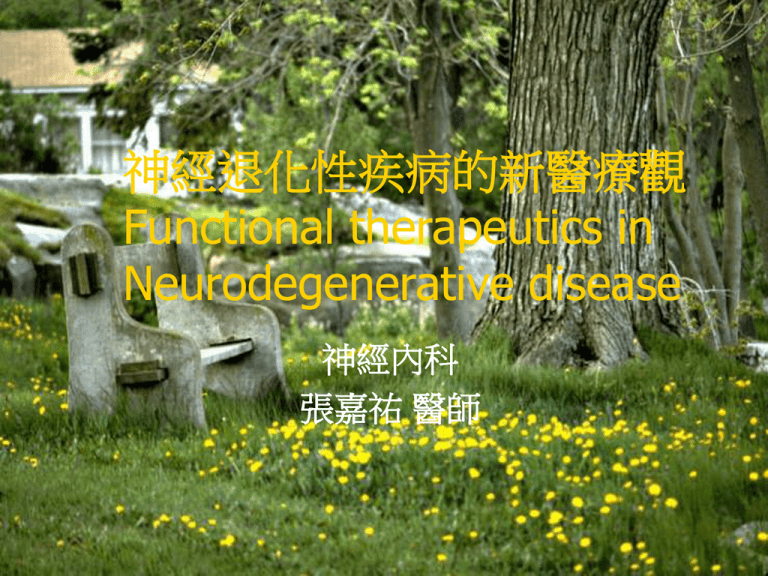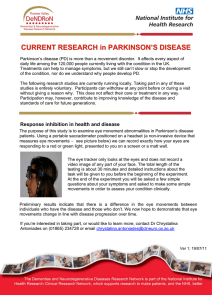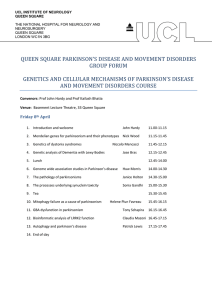神經退化性疾病的新醫療觀 Functional therapeutics in Neurodegenerative disease 神經內科
advertisement

神經退化性疾病的新醫療觀 Functional therapeutics in Neurodegenerative disease 神經內科 張嘉祐 醫師 WHAT IS FUNCTIONAL MEDICINE ? Functional medicine is a science-based , healthcare approach that assess and treats underlying causes of illness through individually tailed therapies to restore health and improve function. Science-Base Field of Health Care: The Principles Biochemical Individuality Based on Genetic and Environmental Uniqueness Patient-Centered versus Disease-Centered Dynamic Balance of Internal and External Factors Web-like Connections of Physiological Factors Health as a Positive Vitality Not merely the Absence of Disease Promotion of Organ reserve-healthspan Complexity theory: The study of chaos Nonlinear dynamics : a weblike model Small changes in initial conditions lead to large changes in outcome(butterfly effect) Pattern recognition in chaotic systems analysis and prediction of trends Human beings are complex systems; disease are complex “emergent” patterns. PATIENT WORKUP Nutritional Status Immune/Inflammation Oxidative stress GI Function Detoxification Structural Neuro-Endocrine Mind-Body SIGNS SYMPTOMS MEDIATORS TRIGGERS ANTECEDENTS Patient Centered Assessment Mediators, Triggers and Antecedents Antecedents (genetics,experiences,past Illnesses,occupation, Demographic,nutrition, life style) Triggers (microbes,allergens, trauma, Toxins) Biological Mediators (cytokines,prostanoids,ions, NO,kinins,hormones, Neurotransmitters, Free radicals) Alzeimer’s Disease Prevalence 9 8 7 6 affected individuals (millions) 5 4 3 2 1 0 1930 1950 1970 1990 2010 2030 Parkinson’s disease-New perspectives Individuals with specific genetic defects causing hepatic detoxification enzyme dysfunction may develop Parkinson’s disease as a result of exposure to certain environmental xenobiotic chemicals proving neurotoxic Parmacogenetics:a laboratory tool for optimizing therapeutic efficiency Parmacogenetics is the study of the linkage between an individual’s genotype and that individual’s ability to metobolize a foreign compound. Clinical Chemistry 43:2 254-266 (1997) Genetically determined differences in Xenobiotic metabolism as a risk factor in Parkinson’s disease Patients with inherited CYP2D6 cytochrome P450 enzyme deficiency had 2.4 X increased risk for Parkinson’s disease Fundam appl Toxicol, 1996 (30) Xenobiotic metabolism in Parkinson’s disease Severe deficiency of sulfate conjugation in 70% of PD subjects PD may be unusually susceptible to exogenous or even endogenous toxins Neurology, July, 1989 Exotoxins in Parkinson’s disease MPTP Manganese Copper Carbon Monoxide Organic solvents Pesticides Aging, Energy, and Oxidative Stress in Neurodegenerative Disease Energy metabolism Excitotoxicity Oxidative damage Combination of therapies that act at sequential steps may have proved efficacy M.Flint Beal Ann Neurology 1995;38:357-366 Functional Therapeutics In Neurodegenerative disease Mitochondrial Resuscitation Liver Detoxification Free radical scanvengers Neurotrophic factors Using both genetic and biochemical markers to identify patients at risk for neurodegenerative disease. Mitochondrial Resuscitation – improved mitochondrial function Coenzyme Q10 NADH Phosphatidylserine daily dose 120 mg 5 mg twice 100 mg Low 【coenzymeQ10】 Reduced Complex I Activity Increased ROS Formation Coenzyme Q10 (ng/mg protien) in platelet mitochondria Shults, C.W. Ann Neurol, August, 1997, 42:261-64 250 200 150 100 50 0 PD SPOUSE CONTROL Clinical and biochemical correlations in mitochondrial myopathies treated with coenzyme Q10 Bresolin,N. Neurology, June, 1998 Kearn-Sayre syndrome and chronic progressive external opthalmoplegia One year CoQ10 120mg per day Reduction of lactate and pyruvate levels following exercise Generally improved neurologic function Nicotinamide Adenine Dinucleotide(NADH)A New Therapeutic Approach to Parkinson’s Disease Of 885 patients who received NADH, 80% show “moderate to excellent” improvement in their disability Effects of phosphatidylserine in ageassociated memory impairment Neurology 41:644-49, 1991 Phosphatidylserine is one of the key components of neuronal membranes. A marked improvement on performance tests related to memory and learning in a group of 149 memory impaired patients treated with phosphatidylserine for 12 weeks. Liver Detoxification Parkinson’s patients manifest flaws in their ability to detoxify various chemicals to which they are exposed. Glutathione is one of the most important components of the liver’s detoxification system. N-acety-cysteine (NAC), Vitamin E and C, alpha lipoic acid, and herb silymarin Reduced glutathione in the treatment of early Parkinson’s disease Prog Neuropsychopharmacol Biol Psychiatry 20(7): 1159-70, 1996 Intravenous glutathion twice daily for 30 days. All patients improved significantly after glutathione therapy with 42 % decline in disability Once glutathione stopped, the therapeutic effect lasted 2-4 months. Free radical scanvengers – Antioxidants Vitamin E Vitamin C Alpha lipoic acid Vitamin D N-acety-cycteine Acety-L-carnitine Ginkgo bioba 1200 IU 800 mg 80 mg 400 IU 400 mg 400 mg 60 mg A pilot trial of high-dose antioxidants in an attempt to slow the progression of Parkinson’s disease Ann N Y Acad Sci 570:186-96,1989 Evaluate the effectiveness of vitamin E and C in a large group of Parkinson’s patients over several years. The time until patients to required Ldopa therapy was extended 2.2 years. A placebo-controlled, double-blind randomized trial of an extract of Ginkgo biloba for dementia Le Bars, P JAMA October 22, 1997 137 patients, 52 weeks, Egb 120mg/d 27 % treated group improved on standardized cognitive testing Egb actions: homeostasis of inflammation, membrane protection, neurotransmission modulation for antioxidant enzymes in rat brain cortex Kotler, M. Pineal Research , March, 1998 Increased levels of mRNA for glutathione peroxidase, copper-zinc superoxide dismutase, manganese, superoxide dismutase More marked increase with chronic treatment. Once effective treatments are established, future prospects will include using both genetic and biochemical markers to identify patients at risk for neurodegenerative illnesses, so that one can initiate therapy at a presymptomatic stage and hopefully prevent the illness. l






